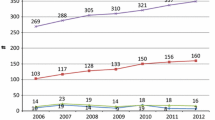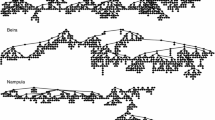Abstract
HIV in the United States is concentrated in populations such as men who have sex with men (MSM), people who inject drugs (PWID), women of color and people living in poverty. These populations are labeled high-risk for HIV infection because of the higher levels of HIV or HIV risk taking behaviors seen in these groups compared to other sub-populations. It is also possible that a group may engage in behaviors that are “high-risk” for HIV infection but never become infected since HIV is not present or not present to a great extent in their social or sexual networks. We analyzed samples of MSM, PWID and high-risk heterosexuals (HRH) collected through the National HIV Behavioral Surveillance (NHBS) system in San Francisco to examine HIV risk taking and HIV burden to determine if the label “high-risk” is appropriately applied. NHBS samples MSM using time location sampling and PWID and HRH using Respondent Driven Sampling. We sampled 508 MSM in 2011, 570 PWID in 2012 and 267 HRH in 2013. There were, as expected, differences in demographic characteristics across the three groups. HRH had a greater number of high-risk behaviors compared to MSM and PWID but had the lowest HIV prevalence. Focusing on risk behavior alone to label populations without considering the background HIV prevalence in communities, the types of risks engaged in and actual HIV infections may obscure which populations truly merit the label “high-risk” for HIV infection.
Similar content being viewed by others
References
CDC (2014) HIV in the United States: At a glance. http://www.cdc.gov/hiv/statistics/basics/ataglance.html. Accessed 12 Mar 2015.
Baggaley RF, White RG, Boily M-C. HIV transmission risk through anal intercourse: systematic review, meta-analysis and implications for HIV prevention. Int J Epidemiol. 2015;39:1048–63.
Chenine AL, Siddappa NB, Kramer VG, et al. Relative transmissibility of an R5 Clade C Simian-Human immunodeficiency virus across different mucosae in Macaques parallels the relative risks of sexual HIV-1 transmission via different routes. J Infect Dis. 2010;201(8):1155–63.
Gallagher K, Sullivan P, Lansky A, Onorato I. Behavioral surveillance among people at risk for HIV infection in the U.S.: The National HIV Behavioral Surveillance System. Public Health Rep. 2007;122:32–8.
MacKellar D, Gallagher KM, Finlayson T, Sanchez T, Lansky A, Sullivan PS. Surveillance of HIV risk and prevention behaviors of men who have sex with men—a national application of venue based, time-space sampling. Public Health Rep. 2007;122 Sup. 1:39–47.
Raymond HF, Chen YH, Ick T, Scheer S, Bernstein K, Liska S, et al. A new trend in the HIV epidemic among men who have sex with men, San Francisco, 2004–2011. J Acquir Immune Defic Syndr. 2013;62(5):584–9. doi:10.1097/QAI.0b013e318285febf.
Heckathorn DD. Respondent-driven sampling: a new approach to the study of hidden populations. Soc Probl. 1997;44:174–99.
Lansky A, Abdul-Quader AS, Cribbin M, Hall T, Finlayson TJ, Garfein RS, et al. Developing an HIV behavioral surveillance system for injecting drug users: the National HIV Behavioral Surveillance System. Pub Health Rep. 2007;122(Suppl 1):48–55.
Magnani R, Sabin K, Saidel T, Heckathorn D. Review of sampling hard-to-reach and hidden populations for HIV surveillance. AIDS. 2005;19(Suppl 2):S67–72.
Coffin PO, Jin H, Huriaux E, Mirzazadeh A, Raymond HF. Trends in use of health care and HIV prevention services for persons who inject drugs in San Francisco: results from National HIV Behavioral Surveillance 2005–2012. Drug Alcohol Depend. 2015;146:45–51. doi:10.1016/j.drugalcdep.2014.10.025.
Raymond HF, Jin H, Scheer S, Ick TO, McFarland W. Efforts to find heterosexual HIV in San Francisco, 2007–2013. AIDS Behav. doi:10.1007/s10461-015-1047-5.
Aral SO. Patterns of sexual mixing: mechanisms for or limits to the spread of STIs? Sex Trans Inf. 2000;76:415–6. doi:10.1136/sti.76.6.415.
Raymond HF, McFarland W. Racial mixing among men who have sex with men. AIDS Behav. 2009;13(4):671–6.
Gregson S, Nyamukapa CA, Garnett GP, Mason PR, Zhuwau T, Carael M, et al. Sexual mixing patterns and sex-differentials in teenage exposure to HIV infection in rural Zimbabwe. Lancet. 2002;359:1896–903.
Service SK, Blower SM. HIV transmission in sexual networks: an empirical analysis. Proc R Soc Lond B Biol Sci. 1995;260:237–44.
Salganick M, Heckathorn DD. Sampling and estimation in hidden populations using respondent driven sampling. Sociol Methodol. 2004;34:193–239.
Acknowledgments
The Centers for Disease Control and Prevention (CDC) funded the collection of data for NHBS; the funder had no role in the analysis or interpretation of data, the writing of the report, or the decision to submit the manuscript for publication.
Author information
Authors and Affiliations
Corresponding author
Rights and permissions
About this article
Cite this article
Raymond, H.F., Ick, T.O. & Chen, YH. A Comparison of Men Who Have Sex with Men, People Who Inject Drugs and High-Risk Heterosexuals’ Risk for HIV Infection, San Francisco. AIDS Behav 20, 417–422 (2016). https://doi.org/10.1007/s10461-015-1181-0
Published:
Issue Date:
DOI: https://doi.org/10.1007/s10461-015-1181-0




